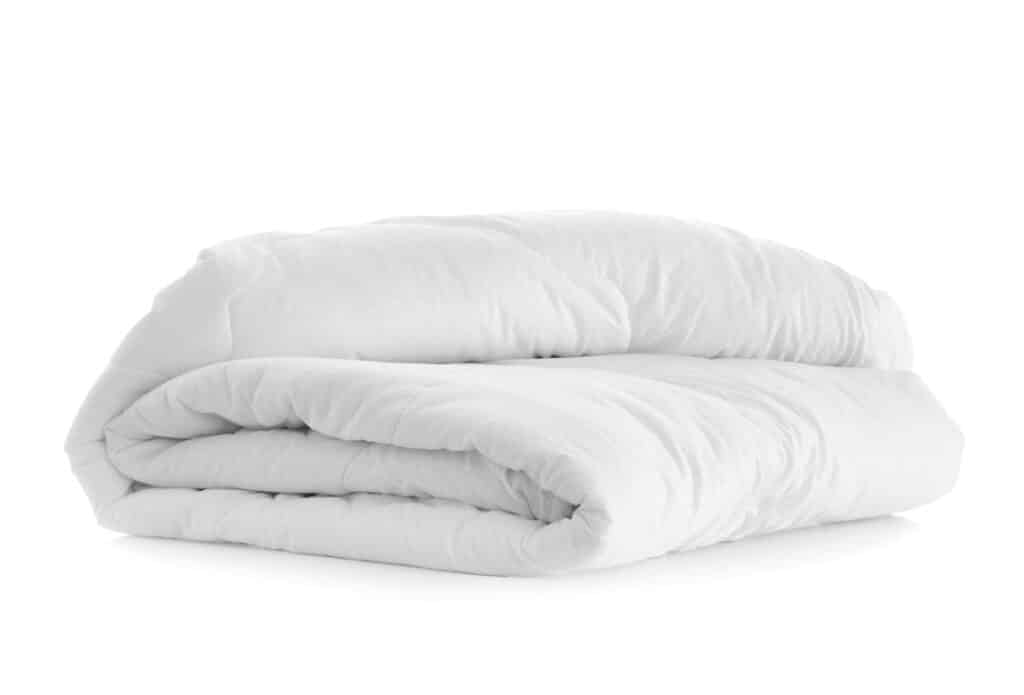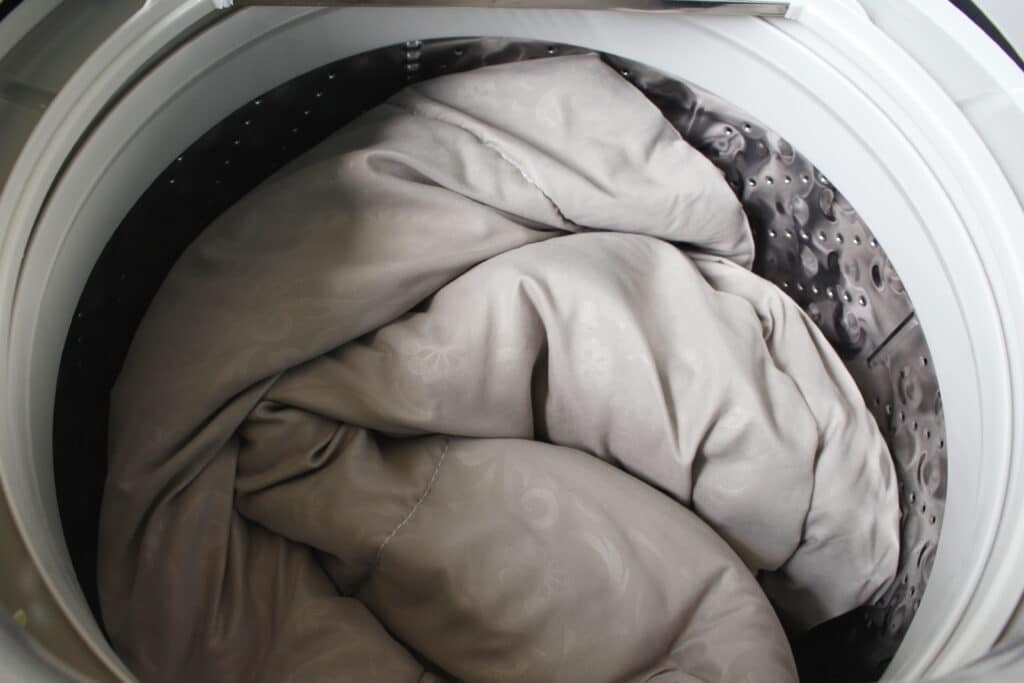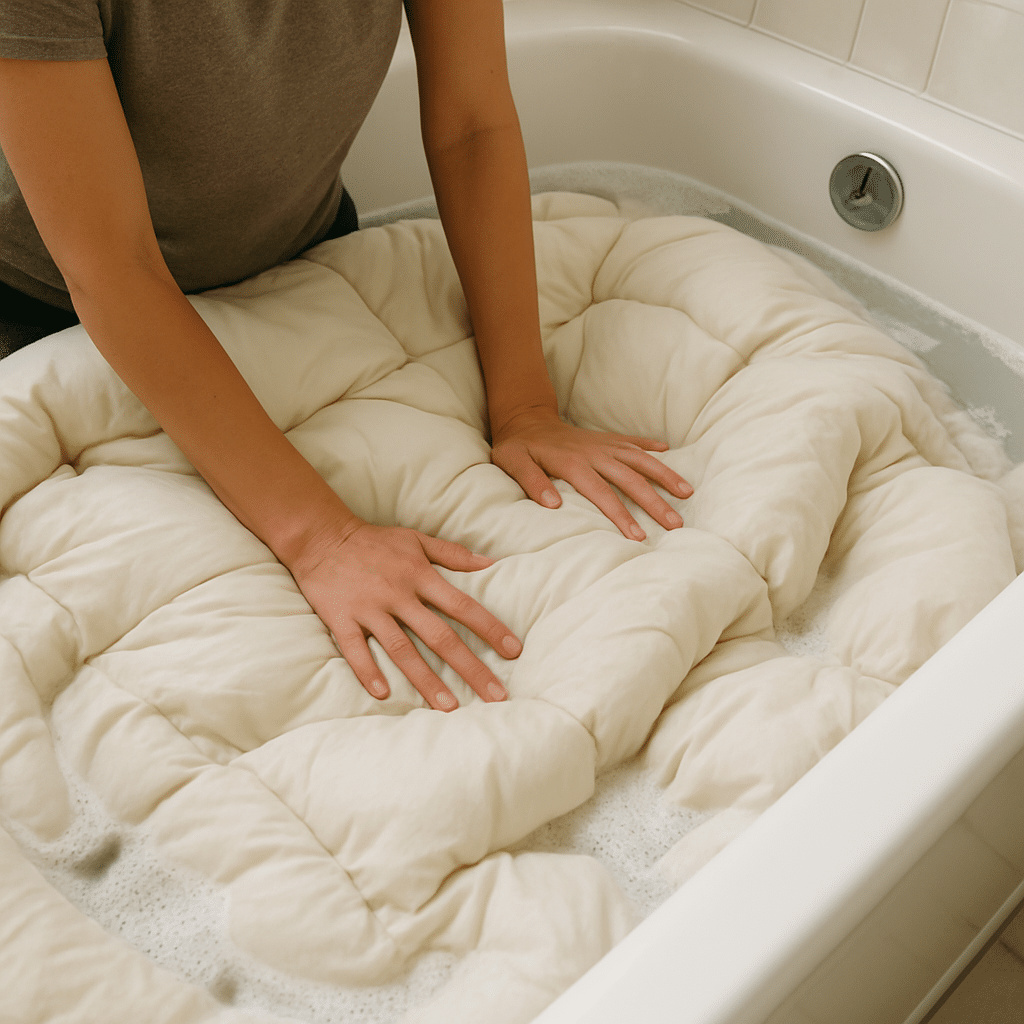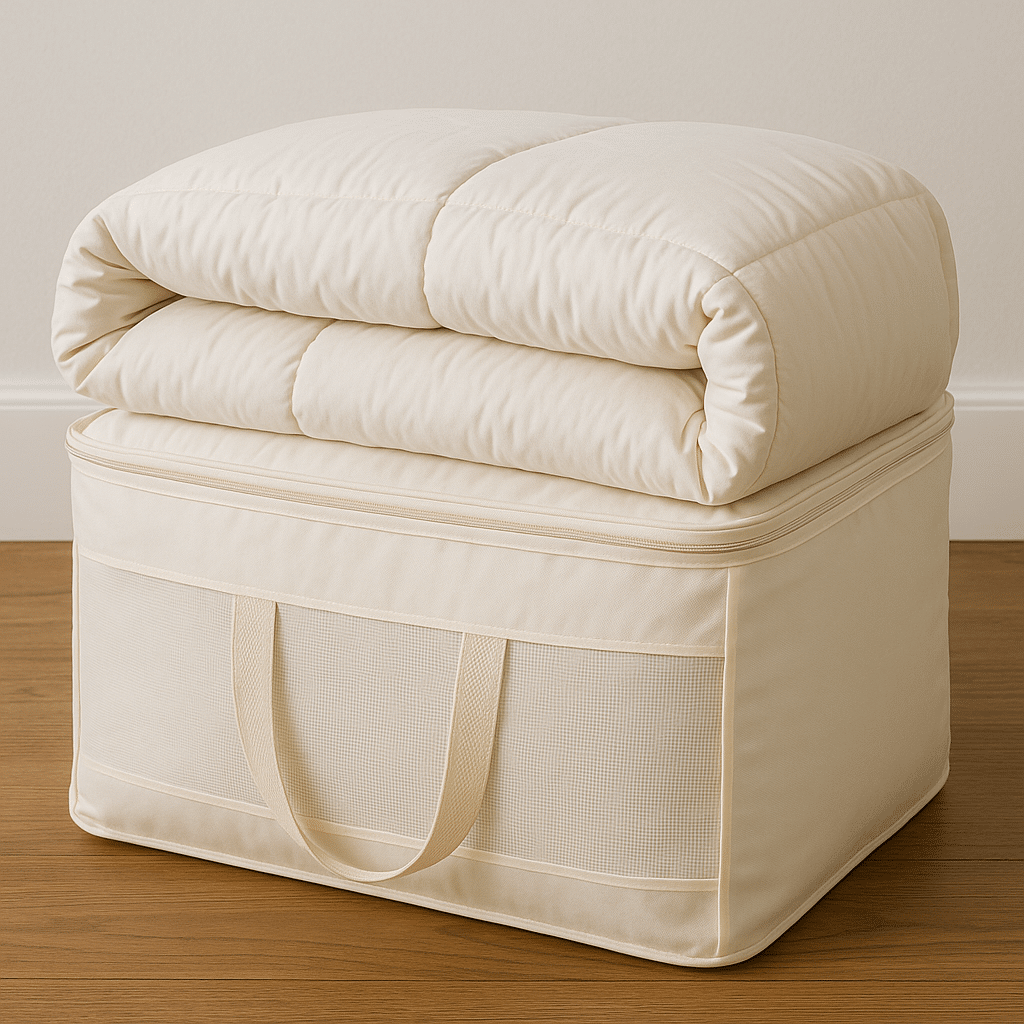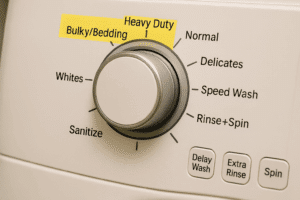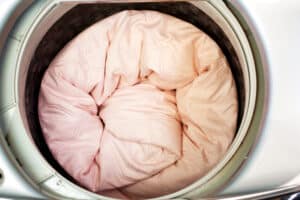How to Wash a Comforter the Right Way
Comforters keep us cozy night after night, but they need occasional TLC to stay fresh. We spend dozens of hours each week sleeping under our bedding, and over time a comforter can accumulate sweat, dead skin, dust mites, and dirt. Cleaning your comforter not only keeps it hygienic – it also helps maintain its fluffy loft and extends its life. Many people put off washing a bulky comforter (understandably, since laundry already takes about 4.5 hours a week for the average American household), but with the right approach you can handle it at home a few times a year. In this guide, we’ll explain how to wash a comforter the right way – whether in the washing machine or by hand – and how to dry it properly. We’ll also cover how often to wash a comforter, tips to keep it fresh between washes, and when it’s smart to use a laundromat or professional service for this big chore.
How to wash a comforter in the washing machine
Check the care label: Before anything else, read the care tag on your comforter. This tells you if it’s machine-washable and notes any special instructions. Most modern comforters (down or down-alternative, cotton or polyester filled) can be washed at home, but some delicate wool or silk comforters may require dry cleaning or hand washing. If the label says “dry clean only,” it’s best to follow that to avoid damage. Otherwise, proceed to wash it yourself. Also inspect your comforter for any tears or loose seams – mend those first so they don’t worsen during washing.
Use a large washer: Comforters need plenty of room to get truly clean. A tightly stuffed washer won’t let water and detergent circulate through the thick filling. If you have a high-capacity front-loading washer (one without a center agitator), that’s ideal. If your home machine is too small for a king-size comforter, don’t force it – head to a laundromat where you can use an extra-large or commercial washer designed for bulky items. (Our self-service laundry in Chicago even has 14-load washers that can comfortably handle big bedding.) Washing a comforter by itself is best – avoid throwing other clothes in at the same time, so the comforter has the whole drum to move around.
Choose the right cycle and temperature: Set your washing machine to a gentle or delicate cycle. Many machines also have a “bulky” or “bedding” cycle – those work great for comforters, as they use more water and a slower spin to protect the fill. Use cold or warm water (not hot) for washing. Hot water can shrink fabrics and is harsh on down feathers and synthetic fibers, while cool water is gentler and still gets the job done. (Bonus: using cold water saves energy and helps prevent wear on fabrics.) If your machine has an extra rinse option, select it – an extra rinse can help flush out any remaining soap from the comforter’s thick filling.
Use mild detergent – sparingly: Resist the temptation to pour in a ton of detergent for such a big item. Too much soap can be hard to rinse out and may leave residue inside the comforter, making it feel stiff or irritate your skin. Instead, use a small amount of a mild, fragrance-free detergent. About one or two teaspoons of liquid detergent, or a single detergent pod, is plenty for a comforter. Avoid bleach and fabric softener, especially for down comforters – bleach can damage fibers and down, and softeners can coat the material and reduce fluffiness. If you’re dealing with stains or odors, pretreat the spots first (with a stain remover or a paste of baking soda) before washing, rather than using more detergent in the load.
Once your comforter is in the machine with detergent, let it soak and wash. When the cycle is done, it’s a good idea to run a second rinse (or even wash cycle without detergent) if you suspect any soap is still in the comforter. This ensures all detergent is fully out, which keeps the fill plush and clean.
Adjust for comforter type: In general, the above method works for most comforters, but here are a few specific tips by fill type:
- Down comforters: Use a gentle, down-safe detergent (or one formulated for delicates) and cold water. Down feathers can lose their natural oils with harsh soap, so stick to mild detergent and rinse very thoroughly. It’s especially important to dry down completely (more on that below) to prevent mildew. Avoid chlorine bleach on down – it can ruin the feathers.
- Synthetic/polyester or cotton fill comforters: These are usually more forgiving than down. Warm water is fine (if the label allows), and a regular mild detergent works. Still use the gentle or bulky cycle to protect stitching. Rinse well, as polyester fill can trap suds. You generally don’t need fabric softener; it can build up on polyester fibers.
- Wool or silk comforters: Check carefully if these are machine-safe. Many wool-filled or silk-filled comforters are labeled dry clean only. If machine washing is allowed, use cold water and a wool-friendly delicate detergent. Avoid agitation as much as possible (perhaps use the shortest gentle cycle). For silk especially, consider using a mesh laundry bag for an extra layer of protection in the washer. When in doubt, it may be better to hand wash or professionally clean wool and silk comforters to avoid shrinkage or damage.
When and how to wash a comforter by hand
Not everyone has access to a large washing machine, and some comforters (like heirloom quilts, wool comforters, or those with sensitive stuffing) are better handled gently. Washing a comforter by hand is an option when machine washing isn’t suitable, but be aware: a wet comforter is heavy and a bit unwieldy. If you decide to hand wash, the bathtub is usually the best place to do it.
Fill the tub: Start by filling a clean bathtub with lukewarm water (cool water for down or very delicate fabrics). Add a small amount of mild laundry detergent to the water, swirling it around to dissolve. Use roughly the same tiny amount you would in a machine – about a couple of teaspoons of detergent. You want suds, but not an overwhelming amount.
Submerge and soak: Gently push the comforter down into the tub, submerging it fully. It will likely try to float – get as much of it underwater as you can. Let it soak for 10-15 minutes to loosen dirt. Then, using your hands, slowly swish and squeeze water through the comforter. You can gently knead sections of it to mimic the agitation of a washer. Avoid wringing or twisting the comforter , as that can damage the fill or stitching.
Drain and rinse thoroughly: Once you feel you’ve washed it, drain the tub and press out as much soapy water as possible from the comforter. Be careful – press or squeeze gently, don’t wring (especially for delicate or down comforters). Refill the tub with clean cool water for rinsing. Work the comforter around in the rinse water, then drain again. You may need to rinse two or three times until no more soap resides in the water. Getting all the detergent out is crucial; leftover soap can make the comforter stiff and attract dirt.
Remove excess water: After the final rinse, press out water by hand as much as you can. It helps to lift sections of the comforter and gently squeeze along the length. You can also lay the comforter flat in the tub and press down with your hands or feet (clean feet, of course!) to push water out. Another trick: lay some large clean towels on the tub floor, place the comforter on them, and roll it up gently – the towels will absorb a lot of moisture.
Hand washing a comforter is time-consuming (and your comforter will be quite heavy when waterlogged), so don’t feel bad if this is one chore you decide to outsource. It’s perfectly fine to skip the DIY soak and take a bulky comforter to the professionals – more on that below. But if you do hand wash, just be patient and gentle, and your comforter will come out clean without a machine.
How to dry a comforter properly
After washing, proper drying is the key to a fluffy, fresh comforter. Comforters are thick and hold a lot of moisture, so they take longer to dry than regular laundry. You have two main options: machine drying or air drying. In both cases, the goal is to get the comforter completely dry to avoid mildew or musty odors.
Tumble dry on low heat: If you have access to a large dryer, this is usually the fastest way. Transfer the comforter to the dryer (it’s okay if it’s still dripping a bit when you move it). Set the dryer to the lowest heat setting or an “air fluff”/no-heat setting if available. It may take a couple of cycles to fully dry a thick comforter on low heat, but slow and steady is better to protect the fabric and filling. Toss in a few dryer balls or clean tennis balls with the comforter – these will bounce around and help break up clumps, fluffing the comforter as it dries. (You might hear some thumping, but it’s worth it for a lofty result!) It can also help to pause the dryer every 30 minutes to take the comforter out and give it a good shake and fluff by hand, then put it back in to continue drying. The comforter is done when it’s completely dry with no damp spots – check the thickest parts especially. Expect it to take anywhere from 1 to 3 hours in a home dryer; large commercial dryers will be faster.
Air-drying a comforter: You can absolutely air-dry a comforter if you don’t have a suitable dryer or want to be extra gentle. The challenge is finding a place to spread it out. The best method is to use a clothesline or drying rack outdoors on a warm, dry day. Lay the comforter out or hang it over multiple lines (to distribute the weight). Every few hours, flip or rotate it and fluff the filling with your hands to help it dry evenly. If drying indoors, use a large drying rack or even the banister of a stairwell – somewhere you can drape the comforter out. It may take a full day or even two for a very thick comforter to air-dry completely. To speed it up, make sure the room is well-ventilated (or use a fan) and consider laying some towels under the comforter to absorb moisture. Sunlight can be helpful too – a few hours in direct sun will freshen the comforter and help kill bacteria. Just avoid leaving colored comforters in harsh sun for days, as it could fade the fabric. As with the dryer, ensure the comforter is 100% dry before you put it back on your bed or store it. Any remaining dampness inside can lead to moldy smells or mildew.
Whichever drying method you choose, patience is key. It’s tempting to crank up the heat to dry faster, but high heat can shrink the comforter fabric or singe filling (especially down). Low heat or air drying takes longer, but it’s much safer for the material. The reward will be a clean, fluffy comforter that’s as inviting as ever.
How often should you wash a comforter?
Unlike sheets and pillowcases, your comforter doesn’t need weekly cleaning. In fact, washing a comforter too frequently can wear it out faster. So, how often is enough? It depends on how you use it and whether it’s protected by a cover.
If you use a duvet cover (and/or a top flat sheet) over your comforter, those layers take the brunt of nightly wear. In this case, the comforter itself only needs a deep cleaning a few times per year. Many bedding experts suggest that washing a comforter twice a year is sufficient when it’s always covered – for example, once around spring cleaning time and once before winter. The removable duvet cover, however, should be washed much more often (ideally every couple of weeks or at least monthly, similar to your sheets) since it’s in direct contact with your skin. By keeping the cover clean, the comforter inside stays clean longer.
If you don’t use a duvet cover and your comforter is directly exposed, plan to wash it more frequently. Aim for about once every season (every 3 months) as a good rule of thumb. Some experts even advise a monthly wash for frequently used comforters without covers – especially if you have allergies or let pets on the bed – but that’s a bit ambitious for most of us. Generally, a comforter that’s not shielded by a cover should get a wash at least 3-4 times a year to clear out the built-up sweat, oils, and dust.
Of course, anytime you have a spill, accident, or someone has been ill in bed, you’ll want to wash the comforter right away regardless of the regular schedule. And always make sure it’s completely dry before putting it back on the bed. In between washes, you can keep your comforter fresh by periodically airing it out (hang it outside on a dry day for a few hours) and by using that duvet cover and top sheet as protective layers.
Tips for keeping your comforter fresh (and stored) between washes
Because we don’t wash comforters as frequently as other bedding, it’s smart to take steps that keep them cleaner for longer. Here are some clean-obsessed, neighbor-approved tips to help your comforter stay fresh in between full washes, and to store it properly when not in use:
- Cover it up: The easiest way to protect a comforter is to use a washable duvet cover. Also use a top flat sheet under the comforter. These barriers catch most of the sweat, body oils, and spills, and they’re much easier to throw in the wash regularly. Your comforter stays cleaner, longer. (Bonus: It’s also simpler to change the look of your bedding by swapping duvet covers!)
- Give it air: At least once a month, air out your comforter on a line outdoors or near an open window. Fresh air and a bit of sun do wonders in refreshing the fibers. This helps remove moisture and odors that might be lingering. Even when you make your bed each morning, fluff the comforter and pull it back for a few minutes to let the bed air out – this prevents excess humidity build-up from night sweats.
- Store smart: When your comforter is not in use (for instance, a heavy winter comforter during summer), make sure it’s completely clean and 100% dry before storing. Place it in a breathable cotton storage bag or a loosely lidded bin – avoid airtight plastic bags which can trap moisture. You can tuck a dryer sheet or a small lavender sachet in with it to maintain a fresh scent. Store it in a cool, dry place away from direct sunlight. Every few months, check on stored comforters and let them air out for an afternoon to keep them fresh and fluffy.
When to use a laundromat or professional service for your comforter
Washing a comforter at home isn’t always practical. Maybe you don’t have a washer big enough, maybe the comforter is too cumbersome, or maybe you simply don’t have the time (laundry already eats up a lot of your week). In these cases, turning to a laundromat or professional laundry service is a smart move – it can save you effort and even yield a better clean.
Use a laundromat for oversized comforters: If your comforter is king-size or very thick and your home washer can’t handle it, take it to a local laundromat. Laundromats have high-capacity machines that make easy work of bulky bedding. You’ll get a more thorough wash because the comforter can actually move around in the drum. Plus, you can usually find oversized dryers there to dry it faster. For example, at our facility we have extra-large washers perfect for big comforters, so you won’t risk damaging your home machine by overstuffing it.
Consider wash-and-fold service: Don’t want to spend half a day at the laundromat or wrestling with a wet comforter? Let the pros handle it. A wash-and-fold laundry service will take your comforter, wash it with the right techniques, dry it completely, and return it neatly folded and fresh. Professional attendants are experienced with bulky items – they know how to get out tough stains and ensure the fill doesn’t clump. It’s basically zero effort on your part. Just drop it off (or have it picked up) and get it back clean and ready to use. This is also a great option if you have multiple comforters or bedding items to clean at once.
Take advantage of pickup & delivery: To really reclaim your time, you can use a laundry pickup and delivery service for your comforter. We’ll come to your home, collect your bedding, and bring it to our facility for professional cleaning, then deliver it back to you fresh and clean. This way, you avoid the hassle entirely – no lugging a huge comforter around. Given that laundry is one of the most time-consuming chores, using a pickup service for a task like comforter cleaning is a huge time-saver. You can spend those hours on more important (or fun) activities while we handle the heavy lifting.
Whether you do it yourself at a laundromat or trust a service, there are extra perks to professional care. We use state-of-the-art equipment and even ozone sanitizing technology to ensure your comforter gets a deep, hygienic clean (far beyond what a home washer can do). Heavy-duty commercial machines can revive a flattened comforter, getting it truly clean and fluffy. And if you’re in Chicago, we’re your neighborhood laundry experts happy to help – in fact, oversized items like comforters are one of our specialties. Sometimes outsourcing this chore is well worth it for the convenience and peace of mind.
Bottom line: You can wash a comforter at home by following the right steps, and it’s something you only need to do occasionally. Keeping your comforter clean ensures you’re sleeping under something that’s fresh, allergen-free, and prolongs the life of your bedding investment. But if the process seems daunting or you’re short on time, don’t hesitate to let our clean-obsessed team handle it. Whether you choose DIY or a professional wash & fold, your comforter will thank you – and you’ll love curling up under that freshly cleaned fluff.

